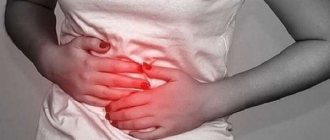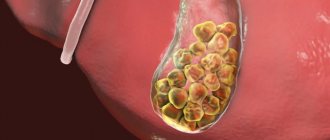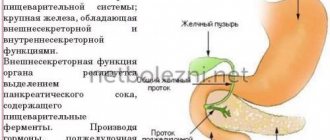Endometriosis is a fairly common disease and affects approximately a third of the female population, usually of reproductive age. Despite the severe consequences that can occur with this disease, diagnosing endometriosis at the initial stage is quite difficult. Sometimes it occurs without pronounced symptoms.
In the absence of proper treatment, severe disease can lead to infertility. Endometriosis can also increase your chance of developing certain types of cancer. Therefore, if you observe unfavorable symptoms, you should immediately make an appointment with a gynecologist and conduct a full diagnosis. As a rule, the main symptom in women is pain due to endometriosis of the uterus. During this period, extremely painful cramps can be felt, which repeatedly led the girl to psychological disorders.
In this article we will try to figure out what to do, how to treat, and why pain with endometriosis is dangerous.
Definition of disease
Endometriosis occurs when the tissue lining the uterus attaches to other vital organs in a woman's body. Despite the fact that the disease is primarily characterized by extremely painful periods, there are many other symptoms that cause discomfort to the fair sex. Scientific studies have proven that the endometrium can affect the area of the ovaries, fallopian tubes, the outer surface of the uterus and intestines. As hormone levels change during the menstrual cycle, this tissue tends to change, which can cause painful adhesions or scar tissue. More than two million women suffering from the progression of endometriosis of one organ or another suffer from intense pain and other equally unpleasant symptoms.
In addition to sharp abdominal pain, many patients experience sciatic and rectal pain during intestinal damage. Women may also experience pain in their legs or during sexual intercourse. Typically, pain becomes more intense during menstruation. This type of disease itself causes a morphological change in the structure of the uterus. In the absence of effective treatment, there is a huge likelihood of developing infertility or, in the case of pregnancy, possible fetal death with subsequent termination of pregnancy. In order to determine the degree and form of the disease, gynecologists carry out the following diagnostic measures.
- take a general blood and urine test;
- perform an ultrasound examination;
- take a gynecological scraping;
- study venous blood analysis.
An ultrasound is performed to determine the location of the enlarged endometrium. Thus, doctors have the opportunity to study the extent of damage to the reproductive system. A scraping is taken to eliminate the risk of developing a malignant tumor. A general analysis reveals the overall picture of the body. The obtained result makes it possible to determine the severity of the progressive pathology, and also helps a qualified medical worker select the most effective and individual treatment method for each girl.
https://youtu.be/jbejchLXNwA
Localization of pain in vaginal endometriosis
When the disease develops in the vaginal area, pain depends on the depth of damage to the walls of the organ and the stage of the disease. If endometriosis is superficial and does not affect any neighboring organs, then the pain may be mild and not always noticeable. Pain increases during menstruation and sexual intercourse, and when deeper lesions occur in the endometrial tissue.
It is this type of disease that is characterized by frequent spread to other areas and organs. Symptoms may include pain when urinating if endometriosis has affected the anterior vaginal wall. Pain sensations can greatly increase with the development of the disease and damage to the rectum, pelvic bones or perineum.
When and where does it hurt?
Generally, endometriosis is characterized by the following types of pain:
- aching;
- pulling;
- localized;
- non-localized.
This disease is dangerous not only because of the pain syndrome, but also because of its complications. The development of pathology can cause the formation of malignant neoplasms. Usually, if there are no positive results after prescribing drug therapy, doctors decide to perform surgery. Endometriosis of the uterus causes pain in the lower abdomen or lower back. At the same time, the patient’s general health deteriorates significantly and her performance decreases. There are pains that can radiate to the lower back, especially during menstruation.
Spasmodic and paroxysmal pain occurs in the chronic form. Pain syndrome is often provoked by physical exercise, sexual relations or natural processes (urination, defecation, etc.). At such moments, girls complain of intense and sharp pain in the abdomen or genitourinary system. Such symptoms often indicate the presence of a pathogenic focus in the ovaries, uterus, cervix, vagina or urinary canal.
Pain in the lower abdomen
Endometriosis can cause cells in the uterus (endometrium) to move outside of the uterus. This causes abdominal pain that is very difficult to describe. This unpleasant phenomenon is convulsive in nature and significantly worsens a woman’s quality of life. This symptom occurs spontaneously, as a result of the development of a pathological process in the pelvic area.
Pain during menstruation
If endometrial damage grows around the sciatic nerve, then this factor is the cause of intense pain during menstruation. During this period, women complain of increased pain syndromes, which are often accompanied by nausea and vomiting. In this case, it is impossible to do without an anti-inflammatory drug. An unpleasant phenomenon occurs three days before menstruation. Accordingly, during this period, the volume of blood loss increases. The following symptoms are observed:
- sudden, paroxysmal heaviness appears in the lower abdomen;
- body temperature rises;
- the patient's general condition worsens;
- painful sensations appear in the peritoneal area, which are aching in nature.
In some cases, this pain can interfere with the ability to move normally.
Pain during sexual intercourse
Sometimes endometrial tissue can rupture and form a knot, which causes pain when mechanically applied. These nodes may appear in the uterine area or in the pelvic cavity. This process often leads to sharp vaginal or abdominal pain during sexual intercourse. When the lesion spreads to the vaginal area, the woman also feels slight discomfort.
Pain when urinating
A similar symptom occurs due to damage to the urethra or bladder by endometriosis. Due to pressure on the area of the urethra, during the process of emptying, the girl feels stabbing and cutting pain in these areas.
Unpleasant sensations during exercise
Intense loads can provoke an unfavorable phenomenon and cause enormous discomfort to a female representative. The cause may be damage to areas of nerve endings. Therefore, with the slightest movement, pain occurs in the abdomen, lower back and back. The pain syndrome can be relieved with an anesthetic drug.
During defecation
This pronounced symptom negatively affects the general condition of a person. Basically, pain occurs when the intestinal canal is damaged. Endometriosis puts pressure on the affected area and therefore the process of defecation is accompanied by pain.
Symptoms of the disease
Endometriosis can manifest itself in different ways, but the main symptom is severe pain in the pelvic area. This may be the only sign of the presence of the disease; pain is especially aggravated before, as well as during the menstrual cycle. You may experience the following symptoms of endometriosis:
- Pain when emptying the bladder;
- Convulsions during sexual intercourse;
- Pain during gynecological examination;
- Pain during sexual intercourse.
A woman may experience severe symptoms of the disease, and in another case, endometriosis may be accompanied by mild pain in the lower abdomen that is not regular. The intensity of pain with endometriosis can change over time, they become worse and more frequent, or, conversely, become less noticeable even without treatment. This does not mean that the body itself has overcome the disease; endometriosis must be treated. Even a sluggish form of the disease can lead to severe complications and infertility of a woman.
Suspicion of the development of this disease may also arise from other sensations of the woman. The following symptoms of endometriosis are very common:
- Bloating, frequent nausea;
- Pain in the abdominal cavity (usually sharp and severe, can be prolonged);
- sudden diarrhea or constipation;
- Irregular menstrual cycle;
- Very painful menstrual bleeding;
- Pain in the lumbar region;
- Discharge of blood during urination;
- Anxiety;
- Depression;
- Headache;
- Severe fatigue, constant feeling of tiredness;
- Blood sugar level below normal – hypoglycemia;
- Susceptibility to many infections and the development of allergic reactions.
In rare cases, you may experience coughing up blood or severe chest pain. This manifests itself when endometriosis develops in a woman’s lungs. The disease in the brain leads to constant headaches and seizures.
Endometrial tissue can develop in various areas of the pelvic organs. The specific symptoms of the disease depend on which part of the body the disease is progressing in. Most often, endometriosis occurs in the following areas of the pelvis:
- The outer surface of the body of the uterus;
- Ovaries;
- Areas between the rectum and vagina;
- Fallopian tubes;
- Intestines;
- Pelvic cavity;
- Areas and organs of the female pelvis.
Pain depending on the stage and form of the disease
The pain syndrome completely depends on the stage of progression and the existing form of the disease. At the initial stage of development, pain with endometriosis practically does not appear, since there is an insignificant degree of organ damage. In such cases, as a rule, pain occurs only under loads or mechanical influences on the affected insides of a woman. The more severe nature of the pathology, accordingly, is accompanied by more intense, spasmodic and sharp pain. The location of the pathological process also affects the nature of the pain syndrome. Thus, when the intestines are damaged, discomfort is felt in the abdomen and rectal passage, and when pathogenic tissues are located in the genitourinary system, pain occurs in the urethra, vagina and lower abdomen.
Pain with endometriosis in the area of the uterine body
Endometriosis in this area of the female genital organs is always accompanied by algodysmenorrhea - severe and acute pain. Pain can appear simultaneously with bloody discharge; it is cramping in nature and always implies bleeding. The main sign of damage to the uterus by endometriosis is severe pain combined with heavy bleeding.
The pain intensifies during sexual intercourse, its intensity can change, increasing or decreasing. It depends on the individual body, but in some cases the pain can become unbearable.
Ovarian endometriosis
Pain with endometriosis in this area is irregular; it intensifies during the menstrual cycle, but may not accompany it every month. You can often notice nausea, vomiting and even loss of consciousness due to these pain sensations.
Ovarian endometriosis is very dangerous due to the possibility of cyst formation. With the unimpeded development of the disease in endometriotic cysts, the integrity of the membrane is disrupted, which leads to internal bleeding.
Endometriosis requires proper diagnosis and a long course of treatment. If symptoms occur, you must contact a gynecological clinic to determine the causes of pain and other abnormalities.
Treatment of endometriosis in women
Treatment of endometriosis is provided in two ways: surgical and conservative. Drug treatment involves the use of hormonal drugs. The treatment regimen is aimed at regulating the production of progesterone and reducing the secretion of estrogen. The drug is determined by the attending physician. Doses are adjusted at each stage of therapy, depending on hormonal tests and ultrasound results.
If the examination revealed an advanced stage of endometriosis, there is a risk of cells degenerating into malignant ones, treatment is provided surgically. The most gentle option is laparoscopy. The surgical intervention does not affect the ability to conceive and bear a child; the damage to the organs of the reproductive system is insignificant. The body recovers due to hormonal therapy in a short time.
Pain is not a marker indicating the development of the process. Its appearance in the pelvic area can signal various diseases, so to determine the diagnosis you need to visit a gynecologist. Endometriosis is a dangerous disease of the female reproductive system. Many organs located in the pelvis are involved in the process. It is better to carry out treatment at an early stage, then conservative methods can be used; in advanced cases, surgery is indicated for the patient. Without therapy, there is a risk of developing tumors.











